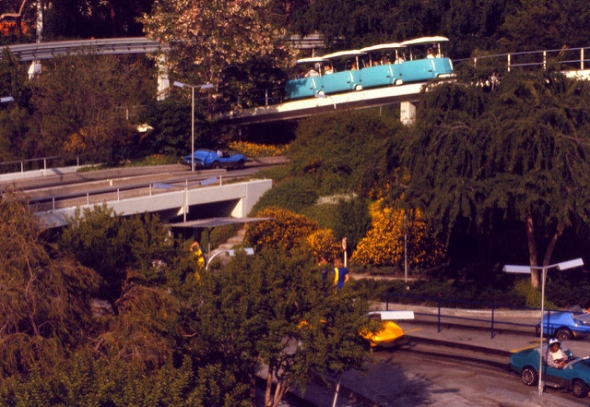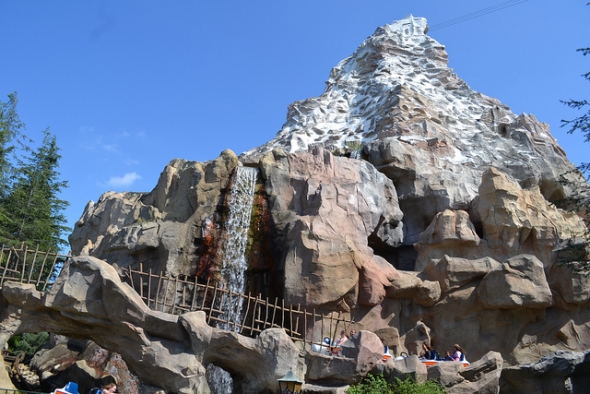4. PeopleMover
Image: Gene Spesard, Flickr (license)
The PeopleMover doesn’t weave its way through the upper quarters of Tomorrowland anymore, in part because of the sheer numbers of accidents, incidents and lawsuits it attracted from 1967 to 1995.
The first notable change to the ride occurred after a barrage of lawsuits in November 1967, when a rare rainy day in Southern California caused the ride vehicles to repeatedly plow into one another. Cars headed for an incline in the track were met with ones that had already started to roll backwards, causing violent collisions from both ends. Several guests were left with permanent facial scars, while still others claimed they sustained various injuries after getting knocked out of their seats. One such guest was even left unconscious in the chaos.
By the time the dust cleared, Disney had settled with 22 of 23 plaintiffs. Imagineers, meanwhile, took every precaution to outfit the ride vehicles with weather-appropriate tires and lifts. Extensive refurbishments enabled the vehicles to handle inclement weather, but it still wasn’t enough to prevent another rash of injuries.
Although the PeopleMover didn’t suffer another serious rainy-day incident, it was shelved for good after a slew of accidents surfaced in the 1970s, 80s and 90s. Unsupervised children and foolhardy teenagers continued to try to climb out of the ride vehicles, sometimes fatally misjudging the attraction’s low MPH and suffering serious harm in the process. Several children lost their toes after the vehicles ran over their feet, and 17-year-old Ricky Lee Yama was killed after trying to jump from car to car and falling onto the track. By the mid-1990s, it was clear that the PeopleMover presented more safety hazards than Disney wanted to deal with, and it was quickly replaced even as its Walt Disney World counterpart continued to be a staple of Tomorrowland.
5. Matterhorn Bobsleds
Image: Loren Javier, Flickr (license)
Some rides required more than a minor safety upgrade. Since its heralded opening in 1959, the Matterhorn Bobsleds had been subject to plenty of revisions, from padded bars to bumpers and two-sled cars to accommodate nearly triple the original number of riders per hour. Vehicles were also controlled by an automated computer program that was designed to anticipate and prevent any potential collisions.
Even computerized systems have their bugs, however, and the Bobsleds were no exception. From 1980 to 1984, several guests were thrown from their sleds after the seatbelt restraints failed to secure them properly. Two were killed as a result, though the court ruled that the incidents were largely due to guest negligence rather than Disney's oversight – that is, riders stood or otherwise tried to exit a moving ride vehicle after being instructed not to do so.
Prior to 2011, guests were loaded into the ride vehicles in tandem. One rider sat in the back of the sled, bracing against the seat back and wrapping their legs around the sides of the person riding in the front. Cast members followed strict guidelines that instructed them to load heavier or larger guests first (in the back of the sled) and lighter or smaller guests second (in the front of the sled). Failure to do so could result in injury or death – and, during the summer of 2011, that’s exactly what happened. A sled was loaded backwards, with the larger passenger sitting in the front, and the passenger in the back of the vehicle sustained neck, shoulder and back injuries after being crushed between his fellow passenger and the metal bar along the seat back.
Disney quickly agreed to a settlement with the plaintiff while the Matterhorn Bobsleds underwent a total renovation. Upon its reopening in January 2012, the sleds featured single-passenger seating, a brand-new height requirement and redesigned seatbelts designed to keep riders securely strapped into their seats.
Today, Disneyland continues to maintain rigorous safety standards to prevent the tragedies of years past from repeating themselves. No theme park can ever offer a 100% guarantee against accidents and malfunctions, but a little care and prevention – watching where you walk, following cast member instructions and avoiding off-limits areas -- can go a long way to ensure that your visit is both safe and magical.



Add new comment